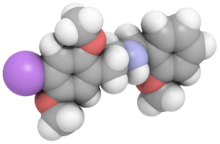NBOMe-2C-I
 |
|
 |
|
| Clinical data | |
|---|---|
| Routes of administration |
Buccal (sublabial), sublingual, insufflated, inhalation, intravenous, intramuscular, rectal |
| ATC code |
|
| Legal status | |
| Legal status |
|
| Identifiers | |
|
|
| CAS Number | |
| PubChem CID | |
| ChemSpider | |
| UNII | |
| ChEMBL | |
| Chemical and physical data | |
| Formula | C18H22INO3 |
| Molar mass | 427.28 g/mol |
| 3D model (JSmol) | |
|
|
|
|
|
|
|
25I-NBOMe (2C-I-NBOMe, Cimbi-5, also shortened to "25I") is a psychedelic hallucinogen that is used in biochemistry research for mapping the brains usage of the type 2A serotonin receptor and later also has been used for recreational purpose. It is derivative of the substituted phenethylamine 2C-I and is the most well-known member of the 25-NB family. It was discovered in 2003 by chemist Ralf Heim at the Free University of Berlin, who published his findings in his PhD dissertation. The compound was subsequently investigated by a team at Purdue University led by David Nichols.
The carbon-11 labelled version of 25I-NBOMe, [11C]Cimbi-5, was synthesized and validated as a radiotracer for positron emission tomography (PET) in Copenhagen. Being the first 5-HT2A receptor full agonist PET radioligand, [11C]-CIMBI-5 shows promise as a more functional marker of these receptors, particularly in their high affinity states.
Street names and media nicknames for this drug are: "N-Bomb", "Solaris", "Smiles" or "Wizard".
Although 25I-NBOMe was discovered in 2003, it did not emerge as a common recreational drug until 2010, when it was first sold by vendors specialising in the supply of research chemicals. In a slang context, the name of the compound is often shortened to "25I" or is called "N-Bomb". According to a 2014 survey, 25I-NBOMe is the most frequently used of the NBOMe series. Case reports of 25I-NBOMe intoxication, with and without analytic confirmation of the drug in the body, are increasing in the medical literature.
25I-NBOMe is widely rumored to be orally inactive; however, oral efficacy has not been disproven and apparent overdoses have occurred via oral administration. Common routes of administration include sublingual, buccal, and nasal/intranasal. For sublingual and buccal administration, 25I-NBOMe is often applied to sheets of blotter paper of which small portions (tabs) are held in the mouth to allow absorption through the oral mucosa. There are reports of intravenous injection of 25I-NBOMe solution and smoking the drug in powdered form.
...
Wikipedia
